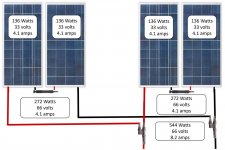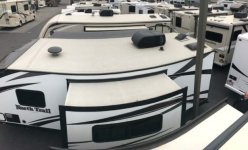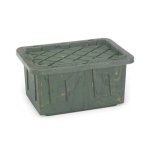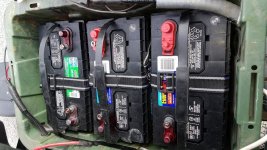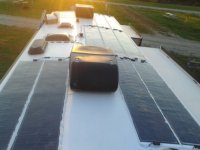How are you getting 7amps?
From reversing your setup (must be in series) you have 3 panels at 32v and 85w each (combined for 96v and 255w). Isn't that only 2.65 amps per string?
finally...".....and is combined immediately prior to the controller."....is this also in series? So, you'd have 765w and 228v going into the controller?
Open-circuit voltage is 32.4 V per panel x 3 = 97.2v (per string) @ 77F cell temperature. Colder temperatures result in higher voltages, Higher temperatures result in lower Voc voltages.
Voltage at max power is 23.3 v per panel 69.9Vmp@77F
Current at max power is 3.6A per panel 3.6A per string @ 77F
Wattage Per panel max power is 23.3V x 3.6A = 83.88 rounded up to 85watt average.
Short circuit current is 4.4 amps per panel 4.4 amps per string
The 7 amp figure is a max limit on the panels circuits breaker.
Each string of three panels are connected in series.
Each string is fed into a combiner box with an independent circuit breaker protecting that string.
The three strings are combine in parallel after the circuit breaker within the combiner box and then the fed to the input on the controller.
Max input voltage of the controller is 150V. The strings never at any temperature should exceed this.
Full panel specs that I used:
http://www.solopower.com/wp-content/uploads/2013/03/solopower_solopanel_sp1_product_specs.pdf
Combiner box used for combining solar panel array.
Midnight solar MNPV3
Used a 7amp breaker per string of 3 panels
http://www.midnitesolar.com/pdfs/frontBack03.pdf
With high voltage and low current requirements on the panel strings I was able to use pretty small gauge wire and have pretty long runs at that.
Remember in DC wiring, the total length of both positive and negative wire in the circuit must be used in your calculations for wire size.
- - - Updated - - -
How are you getting 7amps?
From reversing your setup (must be in series) you have 3 panels at 32v and 85w each (combined for 96v and 255w). Isn't that only 2.65 amps per string?
finally...".....and is combined immediately prior to the controller."....is this also in series? So, you'd have 765w and 228v going into the controller?
Open-circuit voltage is 32.4 V per panel x 3 = 97.2v (per string) @ 77F cell temperature. Colder temperatures result in higher voltages, Higher temperatures result in lower Voc voltages.
Voltage at max power is 23.3 v per panel 69.9Vmp@77F
Current at max power is 3.6A per panel 3.6A per string @ 77F
Wattage Per panel max power is 23.3V x 3.6A = 83.88 rounded up to 85watt average.
Short circuit current is 4.4 amps per panel 4.4 amps per string
The 7 amp figure is a max limit on the panels circuits breaker.
Each string of three panels are connected in series.
Each string is fed into a combiner box with an independent circuit breaker protecting that string.
The three strings are combine in parallel after the circuit breaker within the combiner box and then the fed to the input on the controller.
Max input voltage of the controller is 150V. The strings never at any temperature should exceed this.
Full panel specs that I used:
http://www.solopower.com/wp-content/uploads/2013/03/solopower_solopanel_sp1_product_specs.pdf
Combiner box used for combining solar panel array.
Midnight solar MNPV3
Used a 7amp breaker per string of 3 panels
http://www.midnitesolar.com/pdfs/frontBack03.pdf
With high voltage and low current requirements on the panel strings I was able to use pretty small gauge wire and have pretty long runs at that.
Remember in DC wiring, the total length of both positive and negative wire in the circuit must be used in your calculations for wire size.

